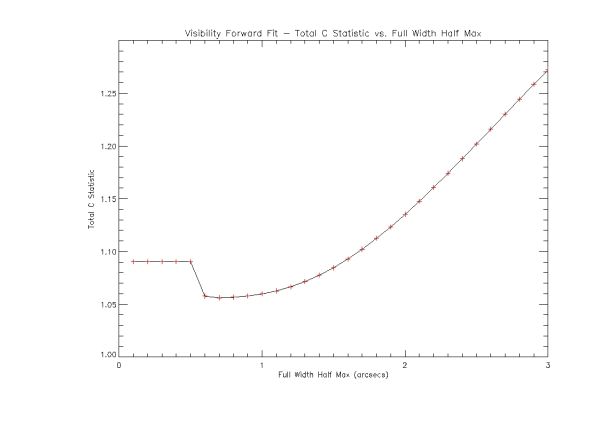Weekly Report 27Aug2010
Visibility Forward Fit - The reduced chi2 and C stastistic (again)
In the following studies an eventlist file for a simulated point source at disk center was used as input to the HESSI image object. RHESSI images were reconstructed from this file using the visibility forward fit algorithm. In all cases below the model of the reconstructed image was a circular gaussian. All parameters of the model were allowed to vary for up to 2000 iterations or until the lowest reduced chi2 was achieved except for one. In the first case the full width half max (FWHM) was held fixed at values ranging from .1 arcsecs to 3 arcsecs. In the second the flux was held fixed at values ranging from 1 photon/cm2/sec to 40 photons/cm2/sec. The reduced chi2, the total C statistic, and the C statistic for each detector were calculated at each point.
Visibility Forward Fit - the reduced chi2 and C statistic for reconstructed images with the FWHM held constant
The plot below shows the reduced chi2 as a function of the FWHM. The FWHM was held at a fixed value and all other parameters were allowed to iterate until the lowest value of the reduced chi2 for the reconstructed image was reached.
The reduced chi2 has a minimum value of .80 at a FWHM of approximately 1 arcsec. Below this value the reduced chi2 for the image remains very close to minimum, When all parameters except for the FWHM are allowed to vary the values of the FWHM between ~.1 arcsec and ~1.1 arcsec all yield reduced chi2 which only differ in the third significant digit meaning that any of these could be considered the best reconstructed image for this source. In order to decide between these images another restriction such as a known value of the flux would have to be imposed. Above ~1.1 arcsec the reduced chi2 rises rapidly as expected. There is very low probability that any of these reconstructed images are accurate given the eventlist input.
Visibility Forward Fit - the reduced chi2 and C statistic for reconstructed images with the flux held constant





